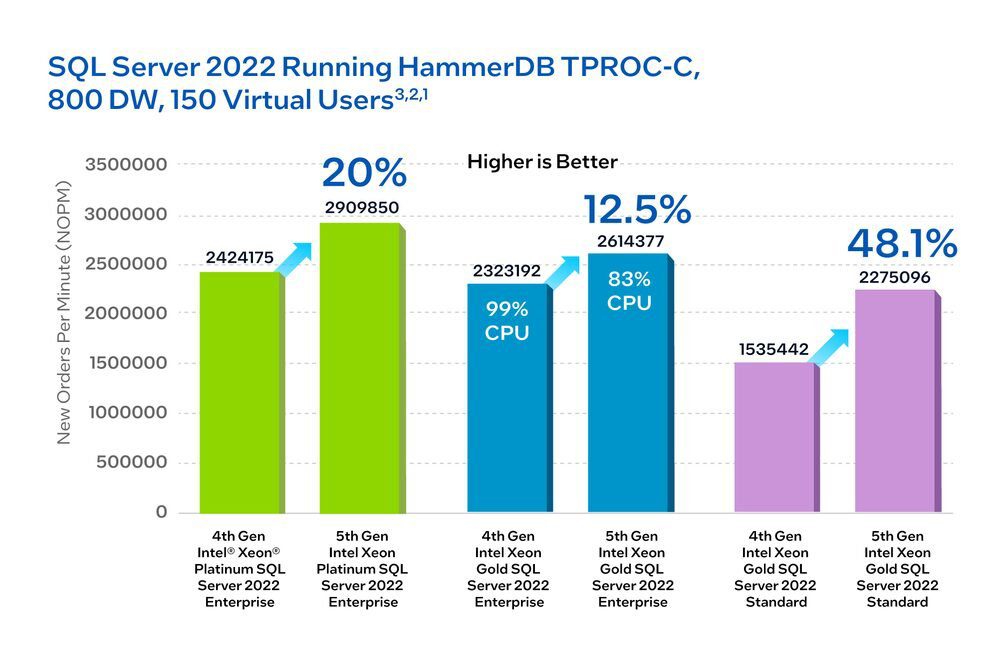5th Gen Intel Xeon Scalable Processors
While speed and scalability have always been essential to databases, contemporary databases also need to serve AI and ML applications at higher performance levels. Real-time decision-making, which is now far more widespread, should be made possible by databases together with increasingly faster searches. Databases and the infrastructure that powers them are usually the first business goals that need to be modernized in order to support analytics. The substantial speed benefits of utilizing 5th Gen Intel Xeon Scalable Processors to run SQL Server 2022 will be demonstrated in this post.
OLTP/OLAP Performance Improvements with 5th gen Intel Xeon Scalable processors
The HammerDB benchmark uses New Orders per minute (NOPM) throughput to quantify OLTP. Figure 1 illustrates performance gains of up to 48.1% NOPM Online Analytical Processing when comparing 5th Gen Intel Xeon processors to 4th Gen Intel Xeon processors, while displays up to 50.6% faster queries.

The enhanced CPU efficiency of the 5th gen Intel Xeon processors, demonstrated by its 83% OLTP and 75% OLAP utilization, is another advantage. When compared to the 5th generation of Intel Xeon processors, the prior generation requires 16% more CPU resources for the OLTP workload and 13% more for the OLAP workload.
The Value of Faster Backups
Faster backups improve uptime, simplify data administration, and enhance security, among other things. Up to 2.72x and 3.42 quicker backups for idle and peak loads, respectively, are possible when running SQL Server 2022 Enterprise Edition on an Intel Xeon Platinum processor when using Intel QAT.
The reason for the longest Intel QAT values for 5th Gen Intel Xeon Scalable Processors is because the Gold version includes less backup cores than the Platinum model, which provides some perspective for the comparisons.
- With an emphasis on attaining near-real-time latencies, optimizing query speed, and delivering the full potential of scalable warehouse systems, SQL Server 2022 offers a number of new features. It’s even better when it runs on 5th gen Intel Xeon Processors.
- Solution snapshot for SQL Server 2022 running on 4th generation Intel Xeon Scalable CPUs. performance, security, and current data platform that lead the industry.
SQL Server 2022
The performance and dependability of 5th Gen Intel Xeon Scalable Processors, which are well known, can greatly increase your SQL Server 2022 database.
The following tutorial will examine crucial elements and tactics to maximize your setup:
Hardware Points to Consider
- Choose a processor: Choose Intel Xeon with many cores and fast clock speeds. Choose models with Intel Turbo Boost and Intel Hyper-Threading Technology for greater performance.
- Memory: Have enough RAM for your database size and workload. Sufficient RAM enhances query performance and lowers disk I/O.
- Storage: To reduce I/O bottlenecks, choose high-performance storage options like SSDs or fast HDDs with RAID setups.
Modification of Software
- Database Design: Make sure your query execution plans, indexes, and database schema are optimized. To guarantee effective data access, evaluate and improve your design on a regular basis.
- Configuration Settings: Match your workload and hardware capabilities with the SQL Server 2022 configuration options, such as maximum worker threads, maximum server RAM, and I/O priority.
- Query tuning: To find performance bottlenecks and improve queries, use programs like Management Studio or SQL Server Profiler. Think about methods such as parameterization, indexing, and query hints.
Features Exclusive to Intel
- Use Intel Turbo Boost Technology to dynamically raise clock speeds for high-demanding tasks.
- With Intel Hyper-Threading Technology, you may run many threads on a single core, which improves performance.
- Intel QuickAssist Technology (QAT): Enhance database performance by speeding up encryption and compression/decompression operations.
Optimization of Workload
- Workload balancing: To prevent resource congestion, divide workloads among several instances or servers.
- Partitioning: To improve efficiency and management, split up huge tables into smaller sections.
- Indexing: To expedite the retrieval of data, create the proper indexes. Columnstore indexes are a good option for workloads involving analysis.
Observation and Adjustment
- Performance monitoring: Track key performance indicators (KPIs) and pinpoint areas for improvement with tools like SQL Server Performance Monitor.
- Frequent Tuning: Keep an eye on and adjust your database on a regular basis to accommodate shifting hardware requirements and workloads.
SQL Server 2022 Pricing
SQL Server 2022 cost depends on edition and licensing model. SQL Server 2022 has three main editions:
SQL Server 2022 Standard
Description: For small to medium organizations with minimal database functions for data and application management.
Licensing
- Cost per core: ~$3,586.
- Server + CAL (Client Access License): ~$931 per server, ~$209 per CAL.
Basic data management, analytics, reporting, integration, and little virtualization.
SQL Server 2022 Enterprise
Designed for large companies with significant workloads, extensive features, and scalability and performance needs.
Licensing
- Cost per core: ~$13,748.
High-availability, in-memory performance, business intelligence, machine learning, and infinite virtualization.
SQL Server 2022 Express
- Use: Free, lightweight edition for tiny applications, learning, and testing.
- License: Free.
- Features: Basic capability, 10 GB databases, restricted memory and CPU.
Models for licensing
- Per Core: Recommended for big, high-demand situations with processor core-based licensing.
- Server + CAL (Client Access License): For smaller environments, each server needs a license and each connecting user/device needs a CAL.
In brief
Faster databases can help firms meet their technical and business objectives because they are the main engines for analytics and transactions. Greater business continuity may result from those databases’ faster backups.


